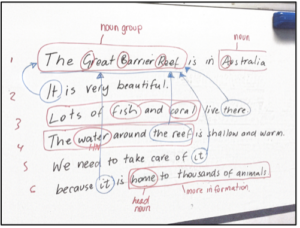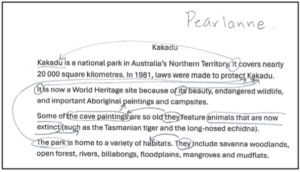A guest post from Lynette Lingard
I use SFL in my EAL classroom to teach language and content side by side. Here’s one example of how it has worked for me.
Three 12-year-old Samoan girls were withdrawn from class for regular EAL lessons with me. The last thing they wanted do was to be taken out of class to learn English, and they let me know about it! They were all struggling with comprehending texts in class, so I planned to teach them how to use the reference system to support their reading and writing.
This is how it unfolded…
I collected a number of short passages about places in Australia, designed for Geography lessons, and at varying levels of difficulty. Each student was given an enlarged copy of the text, and I either projected or copied the text onto the whiteboard, using images to support understanding, both from the original text and by googling images of the places in the text.
We jointly tracked the meanings though the text, marking each reference item (e.g., ‘this’, ‘it’) and what it referred to, and revising noun groups as we worked.
The students and I also considered other language elements that authors used to create cohesion and avoid repetition in a text, like using different words to mean the same thing.
We tracked the meanings together on the board and then the students marked it on their copies.
I followed this pattern each lesson, gradually increasing the level of complexity, and gradually handing more responsibility over to the students to do with a partner, or as a small group.
Once they were confidently tracking meanings in texts, I wrote comprehension questions based on the texts; questions which required them to track meanings to find the answer. The students found the answer in the text, and then we jointly composed their answer in a sentence form, using the question to form the answer, and learning about the patterns of questions and answers. e.g.,
Why is it a World Heritage site?
It is a World Heritage site because…
They learnt to remove the question word, ‘why’, swap ‘is it’ around, and complete the sentence. We did this for a variety of question types and they soon began to identify the patterns in questions and answers themselves.
These were the outcomes
- Improved ability to comprehend texts in their mainstream classroom, observed with delight by their classroom teacher.
- Improved engagement with texts, and with learning in general.
- New enthusiasm for language learning. At the beginning of the term, the students openly hated coming out for EAL lessons. By then end, they were waiting for me to arrive and couldn’t wait to analyse a new text each time we met.
- This work led to writing activities to capitalise on their new-found knowledge of the reference system.
Want to learn more about how to use SFL in your classroom? Read more about the theory.



